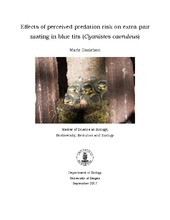Effects of perceived predation risk on extra-pair mating in blue tits (Cyanistes caeruleus)
Master thesis
Permanent lenke
https://hdl.handle.net/1956/16813Utgivelsesdato
2017-10-28Metadata
Vis full innførselSamlinger
Sammendrag
Trivers’ theory of sexual conflict in parental investment has laid the groundwork for immense quantities of research, especially within the avian taxa. Although male benefits of extra-pair copulation (EPC) are argued to be well-understood, female benefits are harder to explain. Nevertheless, EPC is thought to be female driven and so current research is focusing on possible explanations for female benefits. In 2014, Eliassen & Jørgensen suggested that female-driven EPC is based on the spreading of male interest among neighbouring families. EPC creates incentives for male cooperation in a neighbourhood, contributing to benefits for females and her offspring. We tested this, and more specifically looked at possible sex differences between parents regarding antipredator behaviour and extra-pair paternity (EPP) rates. The study was conducted on a blue tit population in southern France, Montpellier. We exposed parental birds to a taxidermy predator or novel object before egg laying. Antipredator behaviour of exposed nests and naïve neighbours was later observed during the chick rearing stage. DNA samples were collected from parents and offspring to determine EPP rates. We found that both parents reduced their antipredator behaviour in nests that contained extra-pair young, both in the form of alarming less and taking fewer risks by keeping a farther distance. We did not find any significant sex differences between parents. Our results showed no difference in EPP rates between predator-exposed and control nests (object-exposed). We did not find any evidence of a difference in antipredator behaviour during chick rearing stage between the different exposed nests, although due to a modest dataset this experiment should be repeated in consecutive years before making any firm conclusions.
